Affordable Thin Lens Using Single Polarized Disparate Filter Arrays for Beyond 5G toward 6G
Abstract
1. Introduction
2. Design of Single Polarized Thin Lens
2.1. Comparison of In-Plane Reactiance for Single/Dual Polarization
2.2. Single-Polarized Low-Pass and Band-pass Unit Cells
2.3. Feeder Design: 4 × 4 Patch Antenna Array
2.4. Lens Implementation Usnig Macro Design
- Step 1:
- The proposed lens is chosen to be located at a distance of 150 mm away from the 4 × 4 patch antenna array. The diameter of the selected aperture for the lens is chosen to be 150 mm. The value of f/D was chosen to be 1.0, where f is the distance between the feed antenna and the lens, and D is the diameter of the lens, to implement a compact and focused design. It should be noted that the target distance also determines the adjustable range of the phase shift.
- Step 2:
- The phase profile of the waves emitted from the 4 × 4 patch antenna array source is captured on the selected aperture at the distance of 150 mm. In this case, the phase profile is captured every 1.5 mm from the center of the lens considering the size of the unit cell, which is 1.5 mm.
- Step 3:
- The phase values needed for collimating radiated rays at all captured points are calculated and matched to the selected unit cells in Table 1. For the interval outside the range of tunable range from −280 to 0°, LP1 and BP5 are used as alternatives.
- Step 4:
- If the type of the unit cell at each point is the same as that at the next point, the area formed by these two points is grouped and classified as a zone.
- Step 5:
- It should be noted that variations in the ILs over the lens aperture might have the same effect as that of the non-uniform magnitude of feeds in a phased antenna array, leading to beam deformation related to beam width, side lobes, and so on [22,23]. Table 2 lists the numbered zones, the number of selected unit cells in each zone, the required phase shift at the center of each zone, and the selected unit cells in each zone. In Table 2, it is assumed that the change in the phase shift due to the different incident angles of the unit cells constituting the proposed lens is not significant.
- Step 6:
- Finally, a macro design of the proposed lens is completed, as shown in Figure 11 through the aforementioned steps. The first and third layers consist only of the capacitive strip unit cells proposed in Section 2.2. In the second layer, both of the capacitive and inductive strip unit elements are repeatedly arranged according to the zone classified in step 5.
3. Fabrication and Measurement
4. Conclusions
Author Contributions
Funding
Conflicts of Interest
References
- 3rd Generation Partnership Project. Study on New Radio Access Technology; 60 GHz Unlicensed Spectrum, 3GPP TR 38.805 version 14.0.0; 3rd Generation Partnership Project: Nice, France, March 2017. [Google Scholar]
- 3rd Generation Partnership Project. Study on Channel Model for Frequencies from 0.5 to 100 GHz, 3GPP TR 38.901 version 14.3.0; 3rd Generation Partnership Project: Nice, France, January 2018. [Google Scholar]
- Rappaport, T.S.; Sun, S.; Mayzus, R.; Zhao, H.; Azar, Y.; Wang, K.; Wong, G.N.; Schulz, J.K.; Sammi, M.; Guiterrez, F. Millimeter Wave Mobile Communications for 5G Cellular: It Will Work! IEEE Access 2013, 1, 335–349. [Google Scholar] [CrossRef]
- Hur, S.; Kim, T.; Love, D.J.; Krogmeier, J.V.; Thomas, T.A.; Ghosh, A. Millimeter Wave Beamforming for Wireless Backhaul and Access in Small Cell Networks. IEEE Trans. Commun. 2013, 61, 4391–4403. [Google Scholar] [CrossRef]
- Rappaport, T.S.; Ben-Dor, E.; Murdock, J.N.; Qiao, Y. 38 GHz and 60 GHz angle-dependent propagation for cellular and peer-to-peer wireless communications. In Proceedings of the IEEE International Conference on Communications (ICC), Ottawa, ON, Canada, 10–15 June 2012; IEEE: Piscataway, NJ, USA, 2012; pp. 4568–4573. [Google Scholar]
- Gutierrez, F.; Agarwal, S.; Parrish, K.; Rappaport, T.S. On-chip integrated antenna structures in CMOS for 60 GHz WPAN systems. IEEE J. Sel. Areas Commun. 2009, 27, 1367–1378. [Google Scholar] [CrossRef]
- Maltsev, A.; Lomayev, A.; Pudeyev, A.; Bolotin, I.; Bolkhovskaya, O.; Seleznev, V. Millimeter-wave toroidal lens-array antennas experimental measurements. In Proceedings of the 2018 IEEE International Symposium on Antennas and Propagation and USNC-URSI Radio Science Meeting Boston, MA, USA, 8–13 July 2018. [Google Scholar]
- Maltsev, A.; Sadri, A.; Pudeyev, A.; Bolotin, I. Highly Directional Steerable Antennas: High-Gain Antennas Supporting User Mobility or Beam Switching for Reconfigurable Backhauling. IEEE Veh. Technol. Mag. 2016, 11, 32–39. [Google Scholar] [CrossRef]
- Pivit, F.; Doumanis, E.; Kozlov, D.; Gueye, M.; Gimersky, M. Compact 60-GHz lens antenna with self-alignment feature for small cell backhaul. In Proceedings of the 2017 IEEE-APS Topical Conference on Antennas and Propagation in Wireless Communications (APWC), Verona, Italy, 11–15 September 2017; IEEE: Piscataway, NJ, USA, 2017; pp. 280–283. [Google Scholar]
- Al-Joumayly, M.A.; Behdad, N. A generalized method for synthesizing low-profile, band-pass frequency selective surfaces with non-resonant constituting elements. IEEE Trans. Antennas Propag. 2010, 58, 4033–4041. [Google Scholar] [CrossRef]
- Behdad, N.; Al-Joumayly, M. A generalized synthesis procedure for low-profile frequency selective surfaces with odd-order bandpass responses. IEEE Trans. Antennas Propag. 2010, 58, 2460–2464. [Google Scholar] [CrossRef]
- Luukkonen, O.; Simovski, C.; Granet, G.; Gousetis, G.; Lioubtchenko, D.; Raisanen, A.; Tretyakov, S. Simple and accurate analytical model of planar grids and high-impedance surfaces comprising metal strips or patches. IEEE Trans. Antennas Propag. 2008, 56, 1624–1632. [Google Scholar] [CrossRef]
- Tretyakov, S.A. Analytical Modeling in Applied Electromagnetics; Artech House: Norwood, MA, USA, 2003. [Google Scholar]
- Yoon, I.; Oh, J. Millimeter-Wave Thin Lens Using Multi-Patch Incorporated Unit Cells for Polarization-Dependent Beam Shaping. IEEE Access 2019, 7, 45504–45511. [Google Scholar] [CrossRef]
- Oh, J. Millimeter-wave thin lens employing mixed-order elliptic filter arrays. IEEE Trans. Antennas Propag. 2016, 64, 3222–3227. [Google Scholar] [CrossRef]
- Oh, J. Millimeter-Wave Short-Focus Thin Lens Employing Disparate Filter Arrays. IEEE Antennas Wirel. Propag. Lett. 2016, 15, 1446–1449. [Google Scholar] [CrossRef]
- Hong, W.; Ko, S.; Lee, Y.; Baek, K. Compact 28 GHz antenna array with full polarization flexibility under yaw, pitch, roll motions. In Proceedings of the 9th European Conference on Antennas and Propagation (EuCAP), Lisbon, Portugal, 13–17 April 2015; IEEE: Piscataway, NJ, USA, 2015; pp. 1–3. [Google Scholar]
- Hong, W.; Ko, S.; Lee, Y.; Baek, K. Multi-polarized antenna array configuration for mmWave 5G mobile terminals. In Proceedings of the 2015 International Workshop on Antenna Technology (iWAT), Seoul, Korea, 4–6 March 2015; IEEE: Piscataway, NJ, USA, 2015; pp. 60–61. [Google Scholar]
- Baek, K.; Hong, W. Highly miniaturized vertical end-fire antenna array for mmWave wireless communication. In Proceedings of the 2013 IEEE Antennas and Propagation Society International Symposium (APSURSI), Orlando, FL, USA, 7–13 July 2013; IEEE: Piscataway, NJ, USA, 2013; pp. 992–993. [Google Scholar]
- Karthikeya, G.S.; Abegaonkar, M.P.; Koul, S.K. Low cost high gain triple band mmWave Sierpinski antenna loaded with uniplanar EBG for 5G applications. In Proceedings of the 2017 IEEE International Conference on Antenna Innovations & Modern Technologies for Ground, Aircraft and Satellite Applications (iAIM), India, Bangalore, 24–26 November 2017; IEEE: Piscataway, NJ, USA, 2017; pp. 1–5. [Google Scholar]
- Al-Joumayly, M.A.; Behdad, N. Wideband planar microwave lenses using sub-wavelength spatial phase shifters. IEEE Trans. Antennas Propag. 2011, 59, 4542–4552. [Google Scholar] [CrossRef]
- Kim, E.; Ko, S.; Lee, Y.J.; Oh, J. Millimeter-wave tiny lens antenna employing U-shaped filter arrays for 5G. IEEE Antennas Wirel. Propag. Lett. 2018, 17, 845–848. [Google Scholar] [CrossRef]
- Hum, S.V.; Perruisseau-Carrier, J. Reconfigurable Reflectarrays and Array Lenses for Dynamic Antenna Beam Control: A Review. IEEE Trans. Antennas Propag. 2014, 62, 183–198. [Google Scholar] [CrossRef]
- Chen, X.; Qu, S. Planar lens antenna based on low-pass frequency selective surfaces. In Proceedings of the 2017 International Applied Computational Electromagnetics Society Symposium (ACES), Suzhou, China, 1–4 August 2017. [Google Scholar]
- Kaouach, H.; Belaid, M.A. Design and demonstration of linearly-polarized transmit-arrays in X-band. Proceedings of the 2018 48th European Microwave Conference (EuMC), Madrid, Spain, 25–27 September 2018.
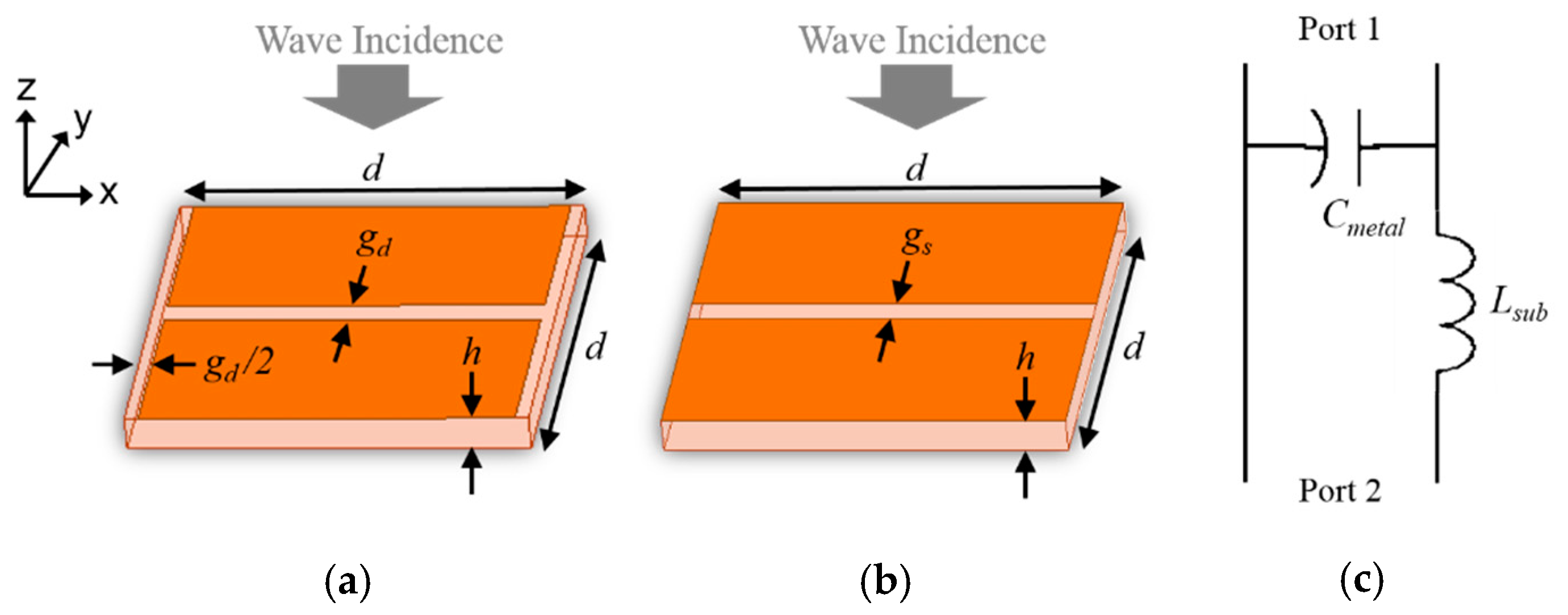

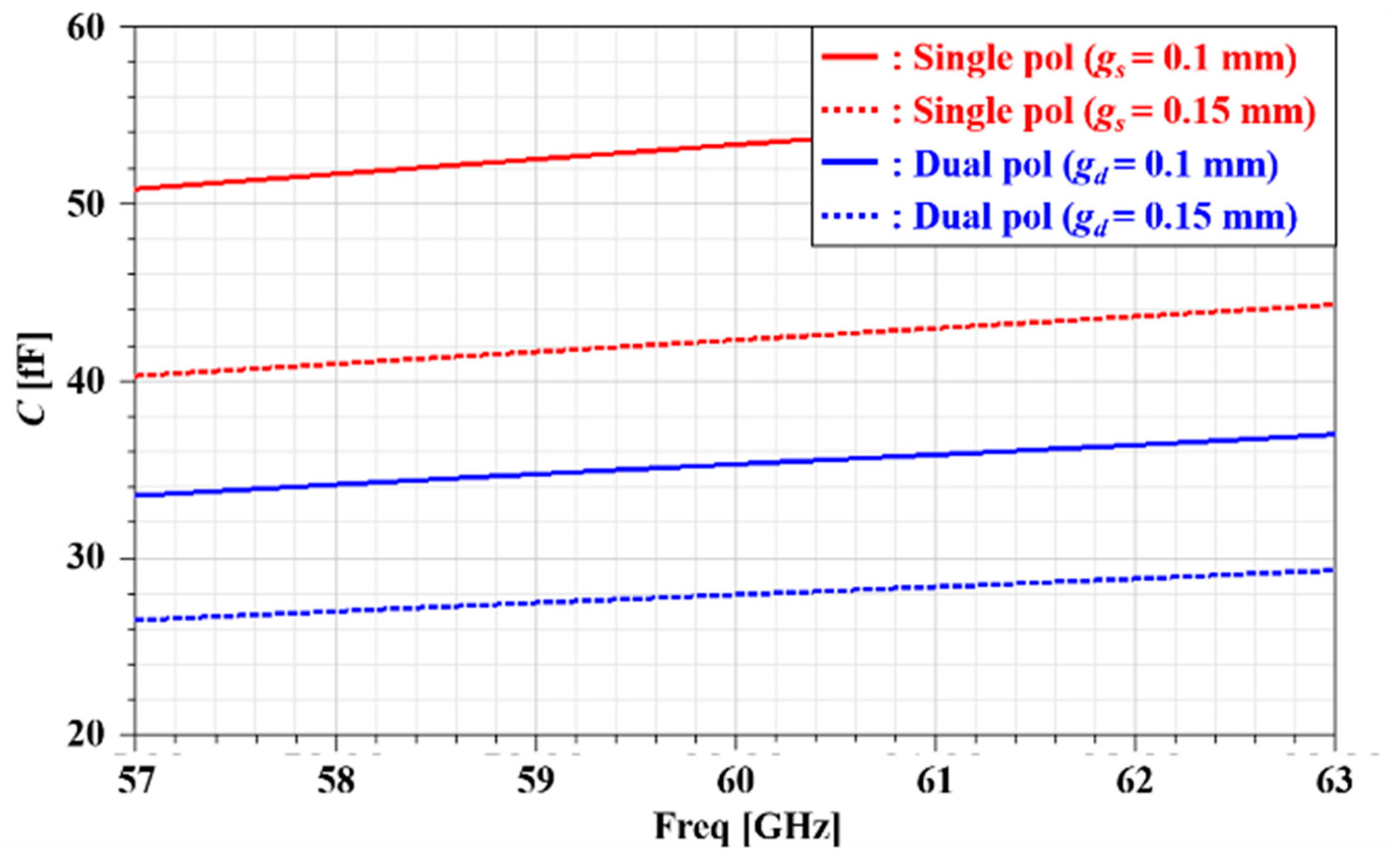

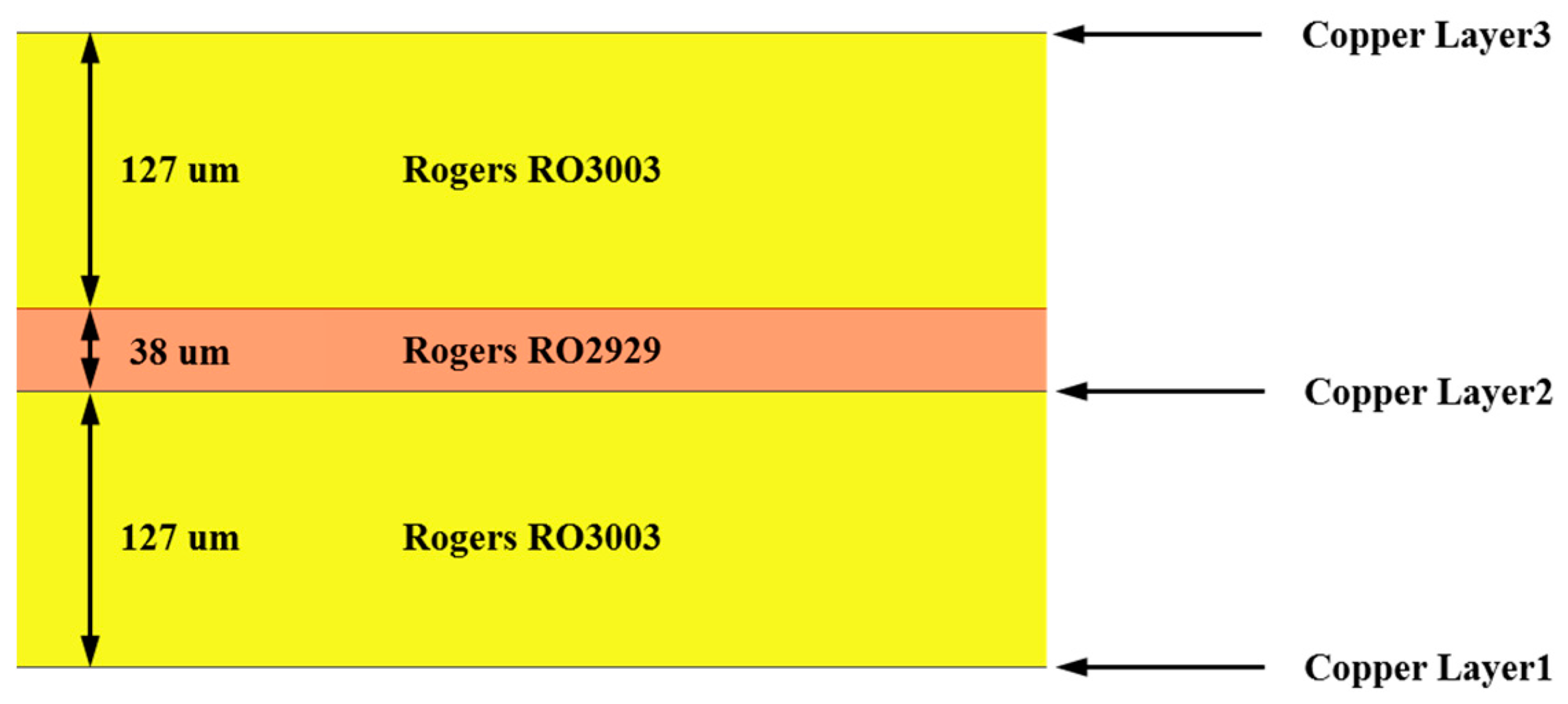
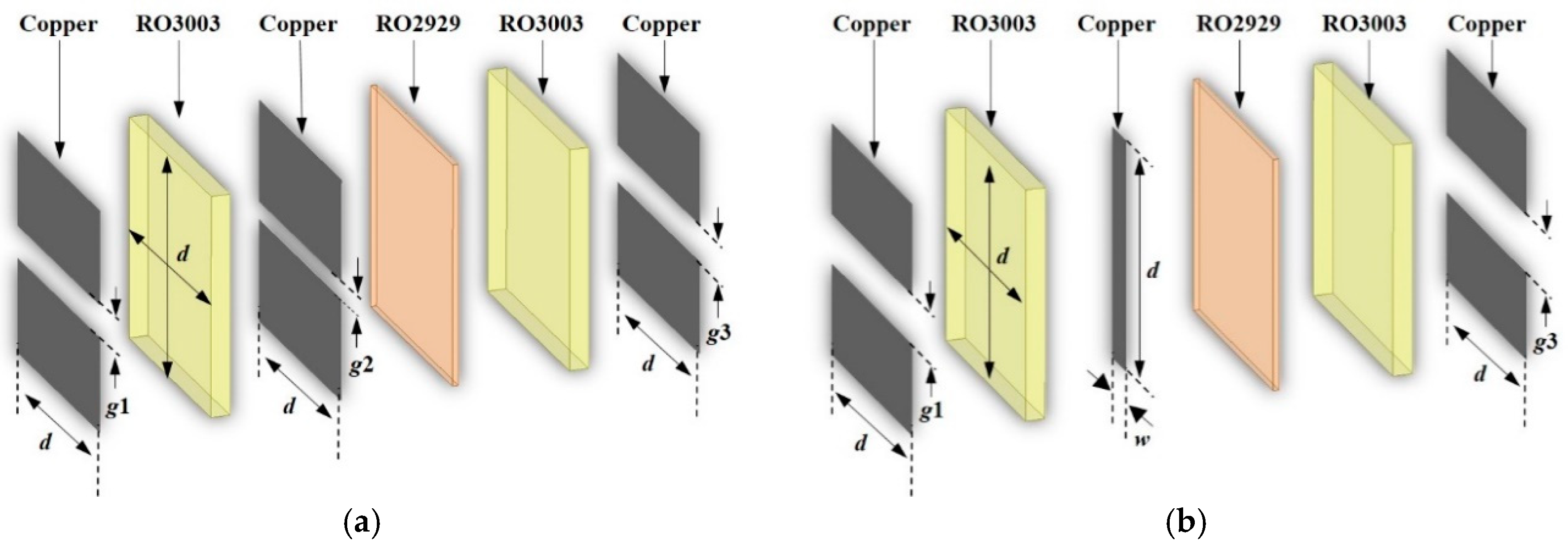


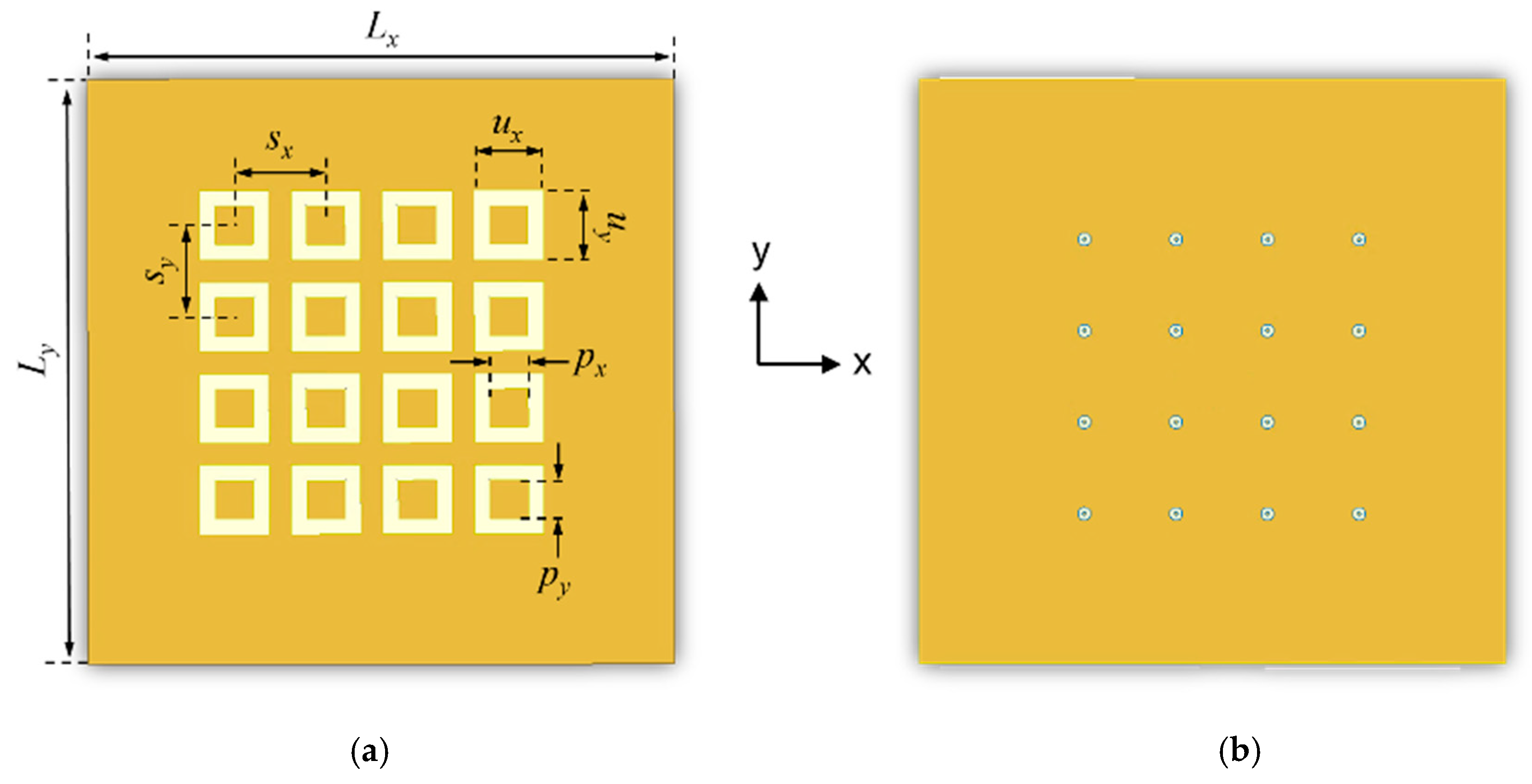


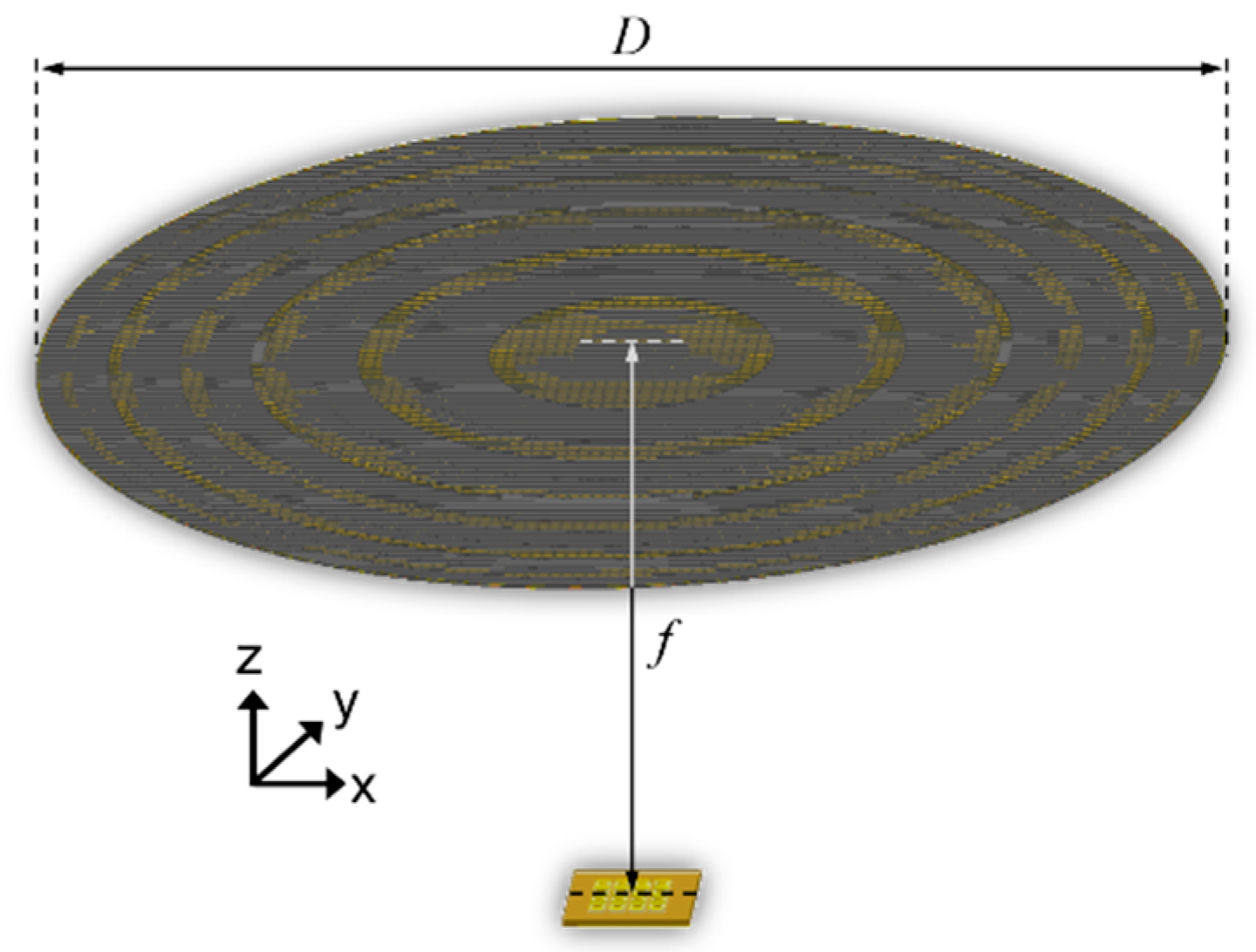

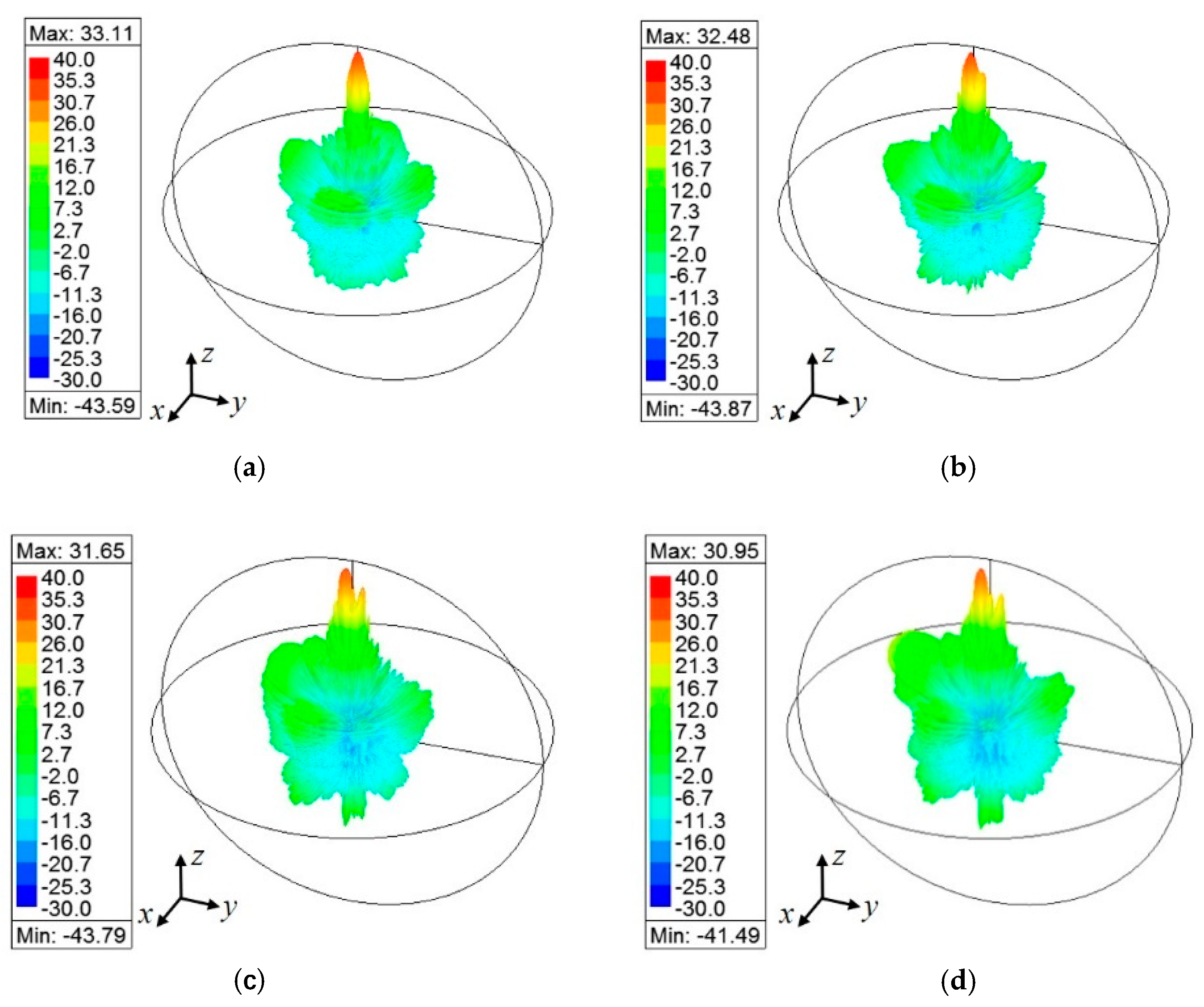
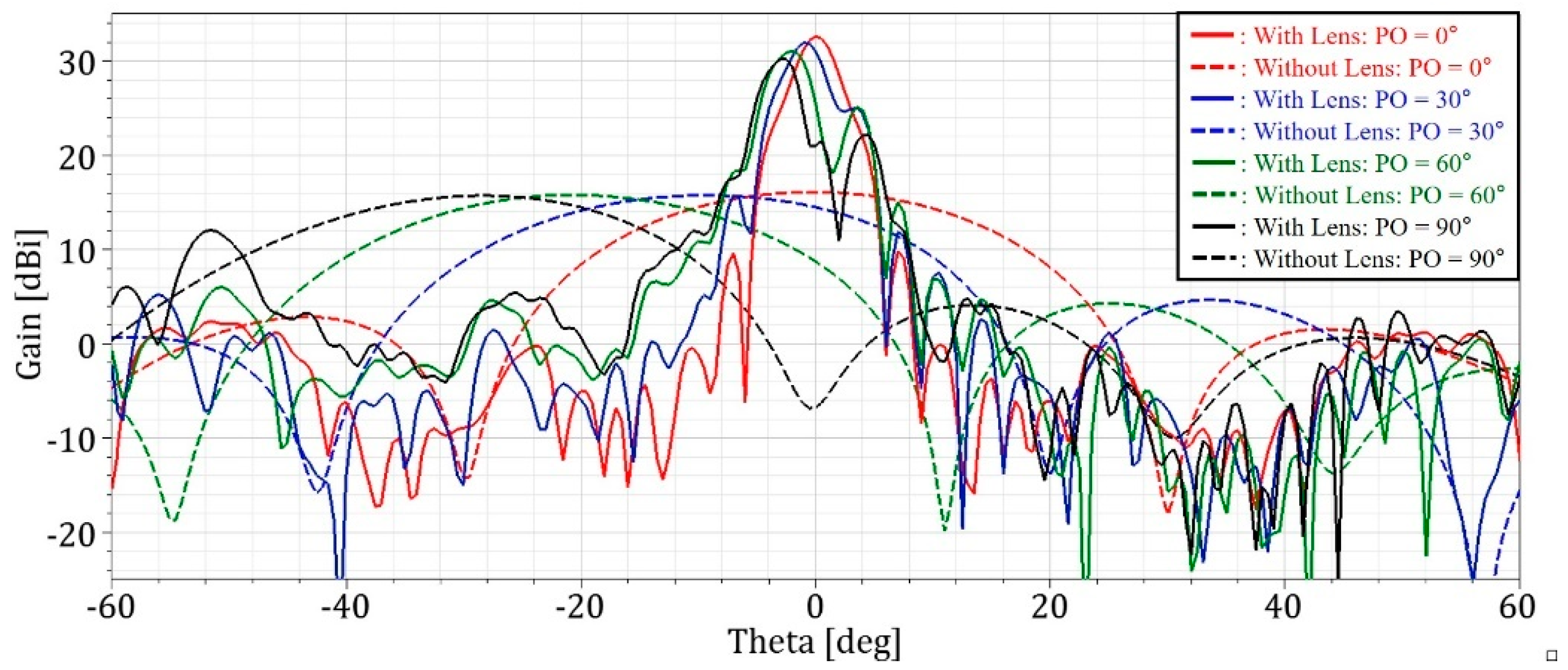

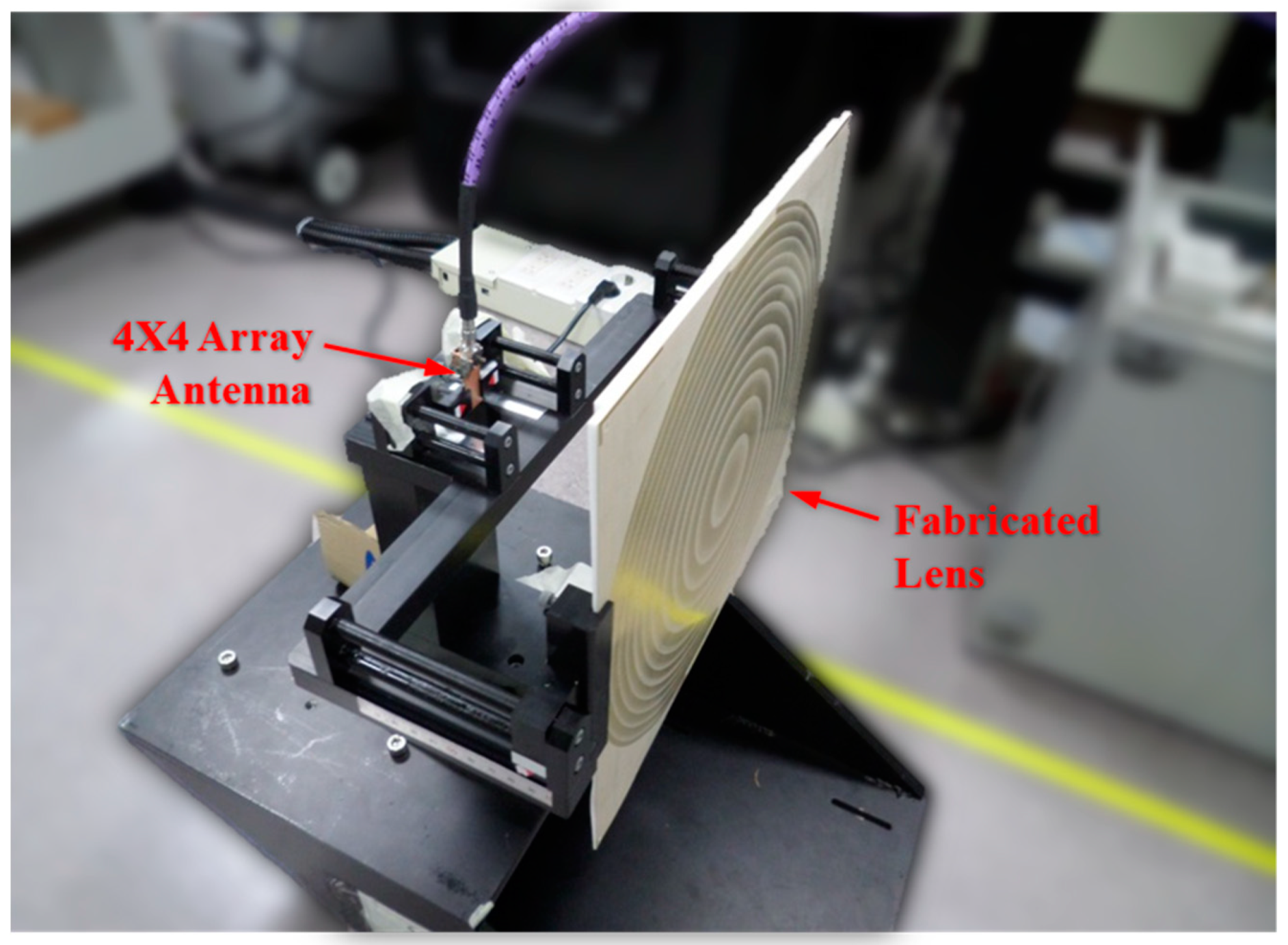

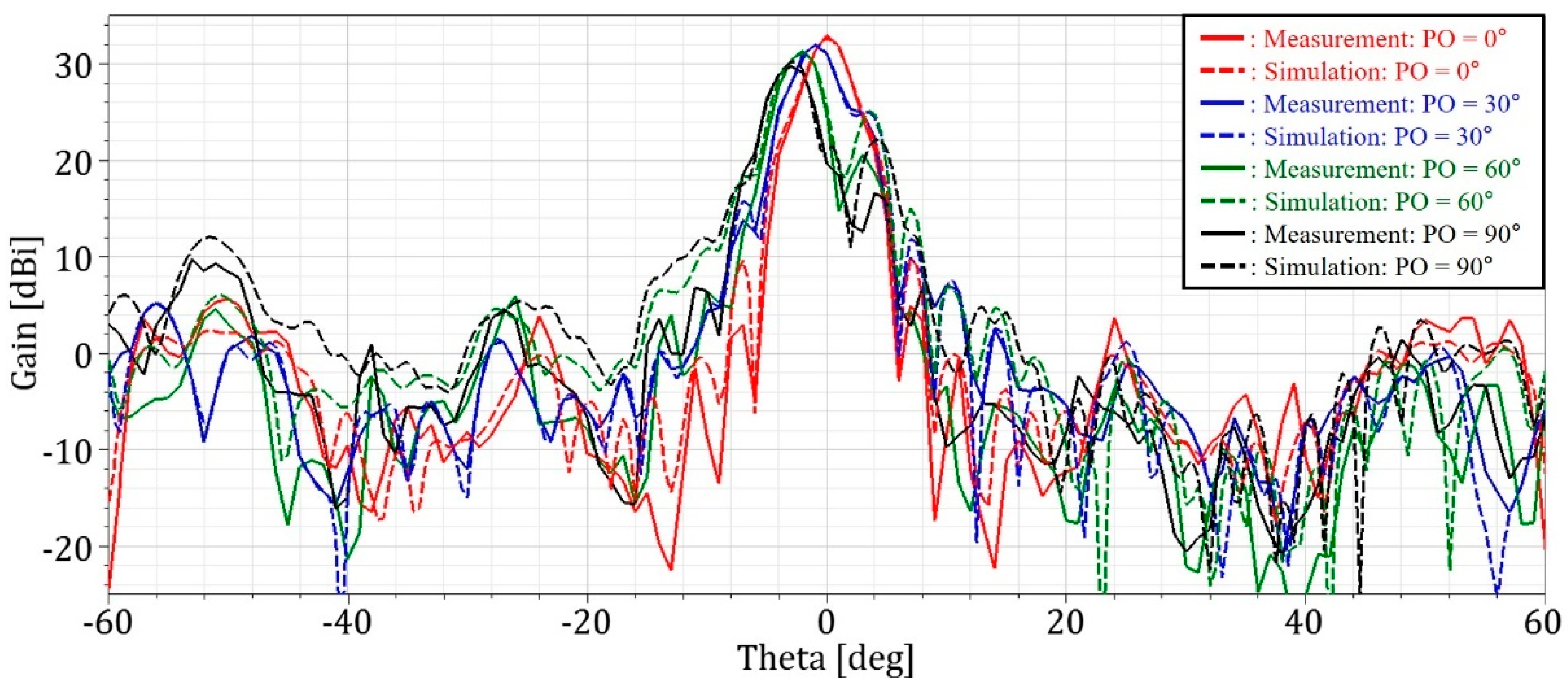
| UC# | Filter Type | g1 (mm) | g2 (mm) | g3 (mm) | w (mm) | Insertion Loss (dB) | Phase Shift (°) |
|---|---|---|---|---|---|---|---|
| LP1 | Low-pass | 0.2 | 0.125 | 0.225 | 0.8 | −276 | |
| LP2 | Low-pass | 0.225 | 0.15 | 0.25 | 0.5 | −236 | |
| LP3 | Low-pass | 0.25 | 0.15 | 0.3 | 0.4 | −208 | |
| LP4 | Low-pass | 0.3 | 0.25 | 0.3 | 0.2 | −167 | |
| LP5 | Low-pass | 0.325 | 0.3 | 0.35 | 0.4 | −142 | |
| BP1 | Band-pass | 0.325 | 0.375 | 0.25 | 0.2 | −115 | |
| BP2 | Band-pass | 0.4 | 0.4 | 0.25 | 0.3 | −98 | |
| BP3 | Band-pass | 0.5 | 0.6 | 0.3 | 0.4 | −63 | |
| BP4 | Band-pass | 0.7 | 0.7 | 0.3 | 0.2 | −27 | |
| BP5 | Band-pass | 0.9 | 0.95 | 0.25 | 0.7 | −2 |
| Zone # | Number of Cascaded Unit Cells | Required Phase Shift in the Middle of Each Zone (deg.) | Selected UC # | Zone # | Number of Cascaded Unit Cells | Required Phase Shift in the Middle of Each Zone (deg.) | Selected UC # |
|---|---|---|---|---|---|---|---|
| 1 | 2 | −108 | BP1 | 21 | 1 | −16 | BP4 |
| 2 | 3 | −96 | BP2 | 22 | 1 | 22 | BP5 |
| 3 | 3 | −64 | BP3 | 23 | 1 | 66 | LP1 |
| 4 | 2 | −24 | BP4 | 24 | 1 | −249 | LP2 |
| 5 | 2 | −18 | BP5 | 25 | 1 | −188 | LP3 |
| 6 | 2 | −67 | LP1 | 26 | 1 | −130 | LP5 |
| 7 | 2 | −235 | LP2 | 27 | 1 | −74 | BP3 |
| 8 | 1 | −191 | LP3 | 28 | 1 | −9 | BP4 |
| 9 | 1 | −154 | LP4 | 29 | 1 | 54 | LP1 |
| 10 | 1 | −121 | LP5 | 30 | 1 | −241 | LP2 |
| 11 | 1 | −83 | BP2 | 31 | 1 | −172 | LP4 |
| 12 | 1 | −45 | BP3 | 32 | 1 | −1058 | BP1 |
| 13 | 2 | −5 | BP5 | 33 | 1 | −38 | BP3 |
| 14 | 1 | 78 | LP1 | 34 | 1 | 31 | BP5 |
| 15 | 1 | −240 | LP2 | 35 | 1 | −256 | LP1 |
| 16 | 1 | −194 | LP3 | 36 | 1 | −183 | LP3 |
| 17 | 1 | −154 | LP4 | 37 | 1 | −111 | BP1 |
| 18 | 1 | −114 | BP1 | 38 | 1 | −41 | BP3 |
| 19 | 1 | −77 | BP2 | 39 | 1 | 32 | LP1 |
| 20 | 1 | −45 | BP3 | 40 | 1 | −251 | LP2 |
© 2019 by the authors. Licensee MDPI, Basel, Switzerland. This article is an open access article distributed under the terms and conditions of the Creative Commons Attribution (CC BY) license (http://creativecommons.org/licenses/by/4.0/).
Share and Cite
Yoon, I.; Oh, S.; Oh, J. Affordable Thin Lens Using Single Polarized Disparate Filter Arrays for Beyond 5G toward 6G. Sensors 2019, 19, 3982. https://doi.org/10.3390/s19183982
Yoon I, Oh S, Oh J. Affordable Thin Lens Using Single Polarized Disparate Filter Arrays for Beyond 5G toward 6G. Sensors. 2019; 19(18):3982. https://doi.org/10.3390/s19183982
Chicago/Turabian StyleYoon, Inseop, Seongwoog Oh, and Jungsuek Oh. 2019. "Affordable Thin Lens Using Single Polarized Disparate Filter Arrays for Beyond 5G toward 6G" Sensors 19, no. 18: 3982. https://doi.org/10.3390/s19183982
APA StyleYoon, I., Oh, S., & Oh, J. (2019). Affordable Thin Lens Using Single Polarized Disparate Filter Arrays for Beyond 5G toward 6G. Sensors, 19(18), 3982. https://doi.org/10.3390/s19183982





